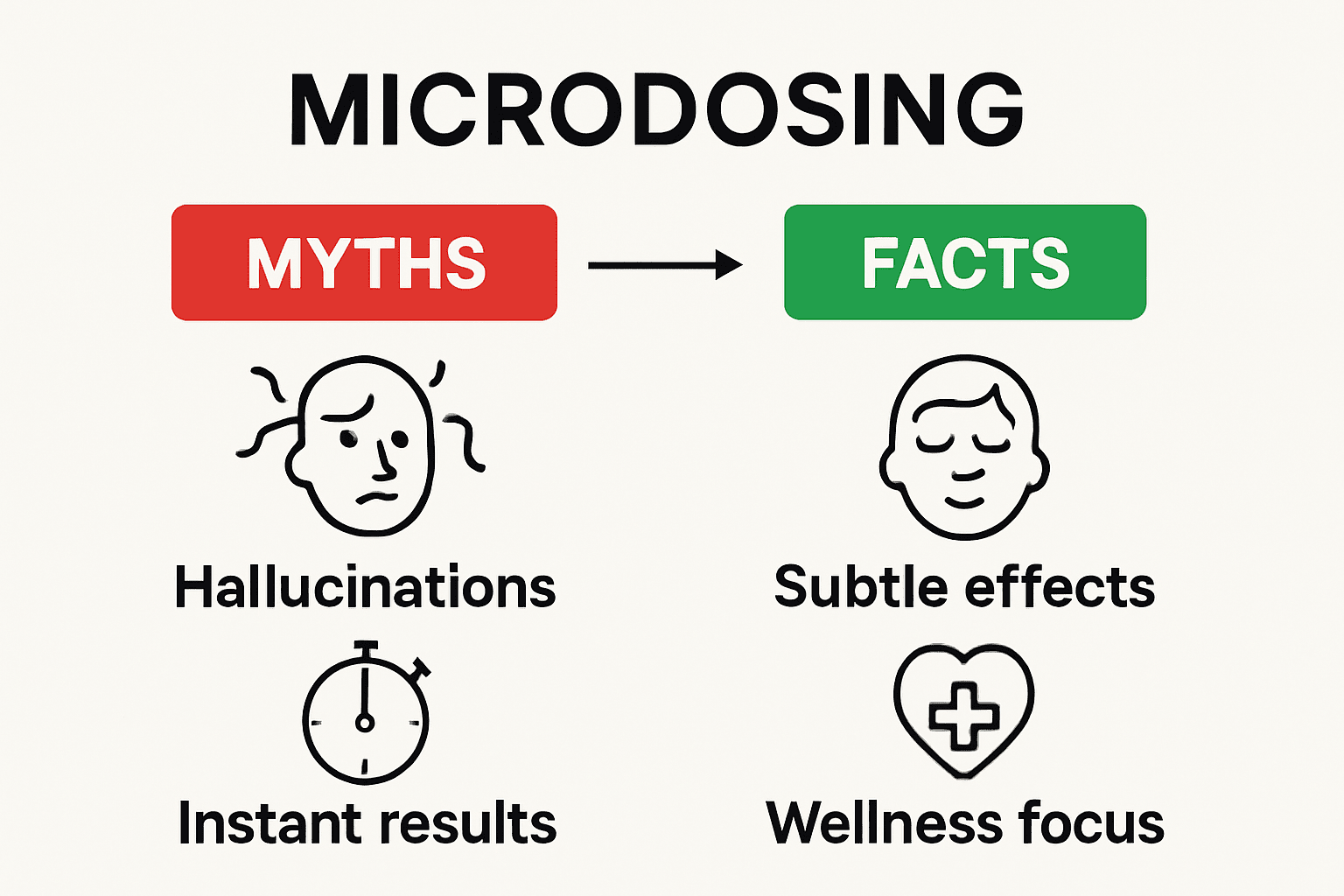Microdosing has captured the curiosity of scientists and wellness seekers alike, drawing attention for its unique approach to psychedelics. But despite its buzz, most people have no idea that microdosing involves just 1/10th to 1/20th of a typical recreational dose—far below the level that creates hallucinations. What surprises many is that with amounts this small, users report subtle changes they can barely notice, and yet the hopes for mental clarity and creativity are fueling a growing wave of research and debate.
Table of Contents
- What Is Microdosing? Defining The Concept
- Examining The Science Behind Microdosing
- Debunking Common Myths About Microdosing
- The Potential Benefits And Risks Of Microdosing
- Understanding Legal And Ethical Considerations
Quick Summary
| Takeaway | Explanation |
|---|---|
| Microdosing involves very low doses. | It typically includes 1/10th to 1/20th of a standard recreational dose. |
| The goal is subtle cognitive enhancement. | Practitioners seek improvements in mental clarity and emotional stability without significant alteration to daily functioning. |
| Placebo effects can influence experiences. | Self-reported benefits may stem from psychological expectations, necessitating rigorous research for validation. |
| Legal status varies by region. | Substances used in microdosing are often classified as controlled substances, complicating legal access and exploration. |
| Educate about risks and ethical concerns. | Responsible microdosing requires informed consultations and understanding potential physical and psychological risks. |
What is Microdosing? Defining the Concept
Microdosing represents a nuanced approach to consuming psychedelic substances at extremely low, sub-perceptual doses that do not produce traditional hallucinogenic effects. According to scientific research, microdosing typically involves consuming approximately 1/10th to 1/20th of a standard recreational dose of substances like psilocybin or LSD.
Understanding Substance and Dosage
At its core, microdosing challenges traditional perceptions of psychedelic consumption by focusing on minimal, controlled intake. The primary goal is not to experience intense psychological alterations but to potentially enhance cognitive function, emotional regulation, and overall wellness. Practitioners aim to achieve subtle neurological benefits without disrupting daily functioning.
Key characteristics of microdosing include:
- Consuming extremely small quantities
- Maintaining normal cognitive performance
- Avoiding hallucinogenic or perception-altering experiences
- Following structured, intentional consumption protocols
Potential Motivations and Context
Individuals explore microdosing for various reasons, including potential improvements in mental clarity, creativity, and emotional balance. Researchers are increasingly examining how these minimal doses might interact with neurological systems. Learn more about microdosing for creativity and focus to understand the emerging perspectives in this emerging wellness approach.
While scientific understanding continues to evolve, microdosing represents an intriguing intersection between traditional psychedelic exploration and modern wellness strategies, offering a controlled, intentional method of potentially supporting mental and emotional well-being.
Examining the Science Behind Microdosing
The scientific exploration of microdosing remains a complex and evolving field, with researchers working to understand its potential neurological and psychological impacts. Contemporary research suggests that while promising, the scientific evidence remains nuanced and requires further rigorous investigation.
Neurological Mechanisms and Potential Effects
Microdosing appears to interact with the brain’s neurochemical systems in subtle yet potentially significant ways. Researchers hypothesize that sub-perceptual doses might modulate neurotransmitter activity, particularly involving serotonin receptors. Preliminary studies indicate potential improvements in neural plasticity, suggesting microdosing could influence cognitive flexibility and emotional processing.
Key scientific observations include:
- Potential enhancement of brain connectivity
- Subtle modulation of neurochemical pathways
- Possible improvements in cognitive flexibility
- Minimal observable perceptual alterations
Research Challenges and Limitations
Scientific understanding of microdosing is currently constrained by significant methodological challenges. Check out our comprehensive guide on microdosing protocols to understand the complexities researchers face. Most existing studies rely on self-reported data, which introduces potential bias and makes objective scientific validation difficult.
Studies have consistently highlighted the strong presence of placebo effects, indicating that psychological expectation plays a substantial role in perceived benefits. Rigorous double-blind, placebo-controlled research is essential to distinguish between genuine neurological changes and subjective psychological experiences.
As scientific investigation continues, microdosing represents a fascinating area of research at the intersection of neuropharmacology, psychology, and wellness, promising insights into how minimal substance interactions might influence human cognitive and emotional experiences.
Debunking Common Myths About Microdosing
Microdosing has become increasingly popular, but numerous misconceptions continue to cloud public understanding. Medical research emphasizes the importance of distinguishing between scientific facts and widespread misinformation surrounding this emerging wellness practice.
Hallucination and Intoxication Misconceptions
One of the most persistent myths is that microdosing produces intense hallucinogenic experiences or significant cognitive impairment. In reality, microdosing involves consuming such minimal quantities that users typically experience no perceptible alterations in consciousness or perception.
 The goal is subtle neurological support, not dramatic psychological transformation.
The goal is subtle neurological support, not dramatic psychological transformation.
Common misconceptions about microdosing include:
- Believing microdoses cause strong hallucinations
- Assuming microdosing leads to immediate cognitive enhancement
- Thinking microdosing is equivalent to recreational psychedelic use
- Expecting instant, dramatic mental health improvements
Safety and Regulatory Misunderstandings
Another significant area of confusion surrounds the safety and legal status of microdosing. Learn more about potential risks and considerations to gain a comprehensive understanding. Many individuals mistakenly believe microdosing is universally dangerous or completely unregulated, when the reality is far more nuanced.
Professional researchers and wellness experts emphasize that responsible microdosing involves careful protocols, medical supervision, and a thorough understanding of individual health contexts. It is not a one-size-fits-all solution but a potentially personalized approach to mental wellness that requires informed, careful implementation.
Ultimately, debunking these myths requires ongoing education, transparent scientific research, and a balanced approach to understanding the potential benefits and limitations of microdosing as a wellness strategy.
The Potential Benefits and Risks of Microdosing
Microdosing represents a complex wellness approach with potential benefits and inherent risks that require careful consideration. Contemporary research suggests that while individuals report promising outcomes, scientific understanding remains nuanced and evolving.
Reported Psychological and Cognitive Benefits
Individuals practicing microdosing frequently describe experiencing subtle yet meaningful improvements in various aspects of mental functioning. Potential psychological benefits may include enhanced mood regulation, increased creative thinking, and improved emotional resilience. These reported experiences suggest microdosing could offer a unique approach to mental wellness that goes beyond traditional therapeutic interventions.
Key potential psychological benefits include:
- Improved emotional stability
- Enhanced cognitive flexibility
- Increased motivation and energy
- Potential reduction in anxiety symptoms
- Subtle improvements in social connectivity
Physiological and Safety Considerations
While potential benefits are intriguing, microdosing is not without potential risks. Learn more about microdosing safety protocols to understand the comprehensive landscape of potential physiological interactions. Potential risks include increased heart rate, potential anxiety triggers, and unknown long-term neurological impacts.
Responsible microdosing requires a comprehensive approach that prioritizes individual health contexts, medical supervision, and ongoing personal monitoring. Individuals considering microdosing should consult healthcare professionals, undergo thorough medical assessments, and maintain transparent communication about their experiences.
Ultimately, microdosing represents an emerging field of wellness exploration that demands balanced, scientifically informed perspectives, combining individual experiences with rigorous medical research and personalized health considerations.
This table outlines the commonly reported psychological benefits and potential physiological risks associated with microdosing as discussed in contemporary research.
| Aspect | Potential Psychological Benefits | Possible Physiological Risks |
|---|---|---|
| Mood | Enhanced emotional stability | Chance of increased anxiety |
| Cognition | Improved cognitive flexibility | Unknown long-term neurological impacts |
| Creativity & Motivation | Increased creativity and motivation | Potential increase in heart rate |
| Social Functioning | Subtle improvement in social connectivity | Individual variability in physical reactions |
| Emotional Resilience | Better stress and emotion management | Requires medical supervision for safety |
Understanding Legal and Ethical Considerations
The landscape of microdosing involves complex legal and ethical dimensions that extend far beyond simple substance consumption. Federal drug classifications highlight the intricate legal challenges surrounding substances typically used in microdosing practices.
Legal Status and Regulatory Challenges
Microdosing exists in a complicated regulatory environment where legal status varies dramatically across different jurisdictions. Substances like psilocybin and LSD remain classified as controlled substances in many regions, creating significant legal barriers for individuals interested in exploring microdosing as a wellness strategy.
Key legal considerations include:
- Varying international and regional drug regulations
- Potential criminal penalties for possession
- Differences in medical versus recreational classification
- Ongoing legal debates about therapeutic use
- Emerging research exemptions
Ethical Implications and Personal Responsibility
Explore our comprehensive guide on microdosing safety protocols to understand the broader ethical landscape. Beyond legal constraints, microdosing raises profound ethical questions about personal autonomy, medical consent, and responsible substance interaction.
Ethical practitioners emphasize the importance of:
- Transparent medical consultation
- Comprehensive personal health assessment
- Understanding potential psychological risks
- Maintaining informed consent
- Respecting individual medical boundaries
Responsible engagement with microdosing requires a nuanced approach that balances personal wellness exploration with rigorous legal and ethical considerations.
 Individuals must navigate a complex terrain of scientific research, regulatory frameworks, and personal health strategies while maintaining a commitment to safety, legality, and informed decision making.
Individuals must navigate a complex terrain of scientific research, regulatory frameworks, and personal health strategies while maintaining a commitment to safety, legality, and informed decision making.
Take the Next Step Toward Microdosing Clarity
If you are tired of confusion and are ready to move beyond myths about microdosing, you are not alone. Many readers come to us after struggling with misinformation about dosing, safety, and how microdosing truly impacts mental wellness. Our MICRODOSING Archives bring together trusted guidance designed for your wellness journey. Here you will find simple and factual resources that support you in making informed, confident choices.

You deserve a path to mental clarity that cuts through the noise. At Kind Stranger, discover microdosed psilocybin products tailored for focus, emotional balance, and cognitive support. Explore detailed product options and safety protocols in our Mental Health Blog. Move from uncertainty to empowered action—visit our site and see how you can experience the true benefits of microdosing today.
Frequently Asked Questions
What is microdosing?
Microdosing involves consuming extremely low, sub-perceptual doses of psychedelic substances, such as psilocybin or LSD, typically around 1/10th to 1/20th of a standard recreational dose. The aim is to enhance cognitive function, emotional regulation, and overall wellness without experiencing hallucinogenic effects.
What are the potential benefits of microdosing?
Individuals practicing microdosing often report subtle improvements in mood regulation, creativity, motivation, and emotional resilience. These benefits suggest microdosing may provide a unique approach to mental wellness that complements traditional therapeutic methods.
Are there any risks associated with microdosing?
Yes, while microdosing may offer potential benefits, it is not without risks. Possible risks include increased heart rate, anxiety triggers, and unknown long-term effects on neurological health. It’s essential to consult healthcare professionals before considering microdosing.
How does microdosing differ from recreational psychedelic use?
Microdosing focuses on consuming minimal quantities that do not produce perceptual changes or hallucinations, unlike recreational use, which aims for intense psychological experiences.
The following table summarizes the key differences between microdosing and recreational psychedelic use, helping clarify common misconceptions about their purpose and effects.
| Aspect | Microdosing | Recreational Use |
|---|---|---|
| Dosage | 1/10th to 1/20th of a recreational dose | Full dose for pronounced effects |
| Goal | Subtle cognitive or emotional enhancement | Hallucinogenic experience, perceptual and psychological change |
| Experiential Effects | No hallucinations or perceptual alterations | Intense hallucinations, altered perception |
| Daily Functioning | No disruption, maintain normal functioning | Significant alteration of consciousness and routine |
| Frequency | Structured, often regular intervals | Occasional, infrequent |
| Context | Wellness, mental clarity, emotional regulation | Recreation, exploration, therapy |
| The goal of microdosing is to enhance cognitive and emotional functioning without significant alterations in consciousness. |
Recommended
- Microdosing and Meditation: Enhance Focus and Wellbeing in 2025 • KIND STRANGER
- Psilocybin Microdosing Schedule Guide 2025: Safe and Effective Plans • KIND STRANGER
- Psilocybin for Social Anxiety: Natural Relief in 2025 • KIND STRANGER
- Risks of Microdosing: What Canadians Should Know in 2025 • KIND STRANGER


Comments
There are no comments yet.